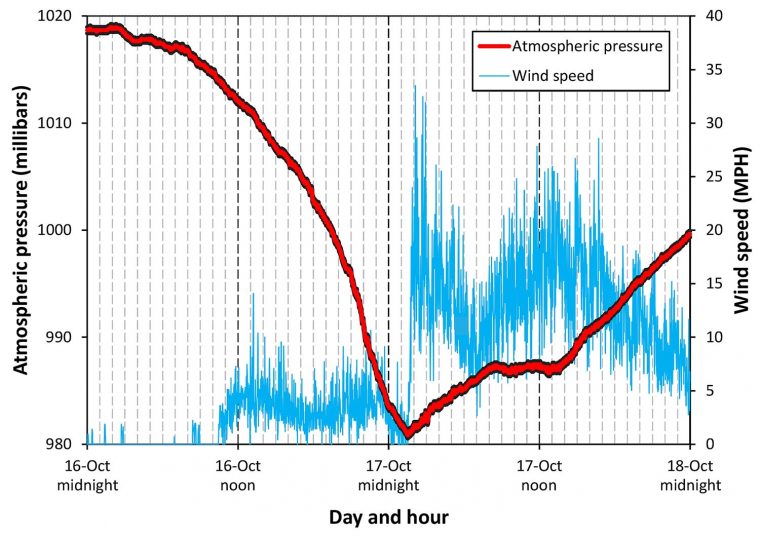On Oct. 17, the Wesleyan Weather Station recorded a dramatic drop in atmospheric (barometric) pressure—a drop so severe it compared to one from Hurricane Sandy in November 2012. Between 2 a.m. on Oct. 16 and 2 a.m. on Oct. 17, the pressure dropped from 1020 to 980 millibars, resulting in what meteorologists refer to as bombogenesis or a "bomb cyclone." Bomb cyclones are defined by a drop of more than 24 millibars of pressure over less than 24 hours, and here, the pressure dropped 40 millibars. During Hurricane Sandy the pressure also dropped to 980 millibars. "We've looked through the…
In this recurring feature in The Wesleyan Connection, we highlight some of the latest news stories about Wesleyan and our alumni. Wesleyan in the News Inside Higher Ed: "The Need for a Recovery of the Humanities" In this essay, President Michael S. Roth responds to the "flood of negativity" in public discourse about higher education, in general, and the humanities, in particular. He suggests that "in order to recover the trust of students and their families, we must overcome our cultivated insularity." 2. NBC News: "Carbon Dioxide Hits a Level Not Seen for 3 Million Years. Here's What That Means for…
New climate research by Dana Royer, professor and chair of earth and environmental sciences, finds that current carbon dioxide levels are unprecedented in human history and, if they continue on this trajectory "the atmosphere could reach a state unseen in 50 million years" by mid-century, according to an article in Salon. The carbon dioxide levels in the atmosphere today are ones that likely haven’t been reached in 3 million years. But if human activities keep committing carbon dioxide to the atmosphere at current rates, scientists will have to look a lot deeper into the past for a similar period. The…
In its most recent meeting, the Board of Trustees conferred tenure on Hari Krishnan, associate professor of dance. He joins seven other faculty members who were awarded tenure earlier this spring. In addition, seven faculty members were promoted to Full Professor: Mary Alice Haddad, professor of government; Scott Higgins, professor of film studies; Tsampikos Kottos, professor of physics; Edward Moran, professor of astronomy; Dana Royer, professor of earth and environmental sciences; Mary-Jane Rubenstein, professor of religion; and Gina Athena Ulysse, professor of anthropology. Brief descriptions of their research and teaching appear below. Associate Professor Krishnan teaches studio- and lecture-based dance courses on Mobilizing Dance: Cinema, the Body, and Culture…
Sixty-six million years ago, a meteorite struck the Earth with enough force that the ensuing environmental changes, including floods, earthquakes, variable temperatures and light-obscuring dust clouds, possibly wiped out dinosaurs and other pre-historic life. Scientists believe this opened a path for mammals, and ultimately humans, to evolve. A new study by Dana Royer, associate professor of earth and environmental sciences, and colleagues from the University of Arizona and the Denver Museum of Nature and Science suggests that the chaos in the wake of the space rock's impact changed the Earth's plant life as well. Deciduous plants survived and flourished to a…
Dana Royer, associate professor of earth and environmental sciences, is the co-author of “Plant Ecological Strategies Shift Across the Cretaceous-Paleogene Boundary,” published in PLOS Biology on Sept. 15. The study reveals that a meteorite that hit Earth 60 million years ago – and may have led to the mass extinction of the world’s dinosaur population – also led to a shift in the landscape of plants, particularly deciduous plants. Royer and his colleagues showed how they applied bio-mechanical formulas to fossilized leaves of flowering plants dating from the last 1.4 million years of the Cretaceous period and the first 800,000 of the Paleogene. Read more about…
Barry Chernoff and Dana Royer are the co-authors of "Diversity in neotropical wet forests during the Cenozoic linked more to atmospheric CO2 than temperature," published in the Proceedings of the Royal Society, B, in 2013. Proceedings B is the Royal Society's flagship biological research journal, dedicated to the rapid publication and broad dissemination of high-quality research papers, reviews and comment and reply papers. The scope of the journal is diverse and is especially strong in organismal biology. Chernoff is the director of the College of the Environment, the Robert Schumann Professor of Environmental Studies, professor of biology, professor of earth…
Dana Royer and Ellen Thomas are among the 21 authors of a review paper, "The Geological Record of Ocean Acidification," published in Science, March 2012: Vol. 335, no. 6072, pages 1058-1063. In the paper, the authors review events exhibiting evidence for elevated atmospheric CO2, global warming, and ocean acidification over the past 300 million years of Earth’s history, some with contemporaneous extinction or evolutionary turnover among marine calcifiers. Ocean acidification may have severe consequences for marine ecosystems; however, assessing its future impact is difficult because laboratory experiments and field observations are limited by their reduced ecologic complexity and sample period, respectively. Royer is…
Three faculty members from Earth and Environmental Sciences, as well as two graduate students and two undergraduate students, presented their research at the annual conference of the American Geophysical Union (AGU) in San Francisco, Calif., Dec. 5-7. The conference drew more than 20,000 scientists and policy makers from around the world. Associate Professors Suzanne O’Connell and Dana Royer, Assistant Professor Phillip Resor, and Austin Reed MA-candidate, Rosemary Ostfeld BA ‘10/MA ‘12, and Julia Mulhern ’12 all attended. In addition, a poster by Katherine Shervais ’13, was also presented. “Our research in the Department of Earth and Environmental Sciences is so…
(more…)
Dana Royer, assistant professor of earth and environmental sciences, assistant professor of environmental studies, accepted the gold Donath Medal at the Geological Society of America’s (GSA) annual meeting in Denver, Colo. Nov. 1. The award came with a cash prize of $10,000. The award recognizes a scientist, aged 35 or younger, for outstanding original research marking a major advance in the earth sciences. On a GSA press release, Peter D. Wilf of Pennsylvania State University said, “Dana is a true innovator who successfully tackles extremely important questions in paleoclimatology and paleoecology, in part using paleobotanical proxies calibrated with a remarkable…
Dana Royer, assistant professor of earth and environmental sciences, has been awarded the Donath Medal by the Geological Society of America (GSA). The Donath Medal is presented to "a young scientist (35 years or younger) for outstanding achievement in contribution to geologic knowledge through research which marks a major advance in the earth sciences." Royer's research interests include global change, paleoclimatology, carbon cycle, paleoecology, paleobotany, plant physiology and light stable isotope geochemistry. He has done extensive studies which have established evidence on how plants affected ancient ecosystems, drawing parallels and evidence from current plant life and conditions. The presentation of the Donath…





